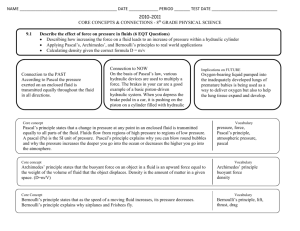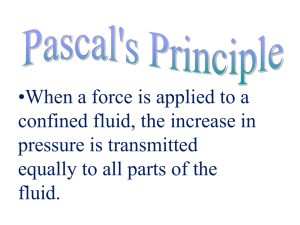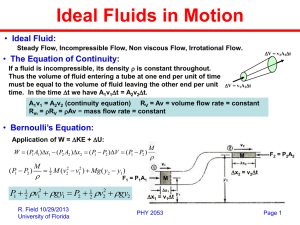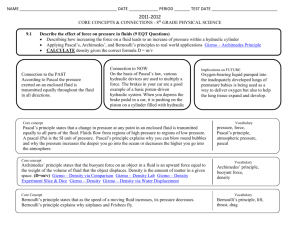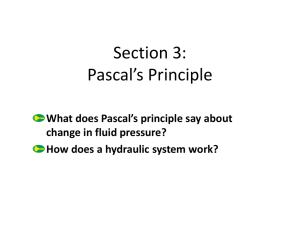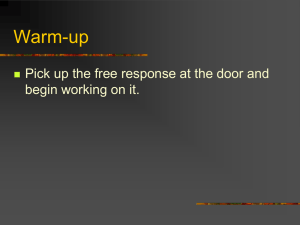Pressure and Fluid Flow - University of Michigan SharePoint Portal
advertisement
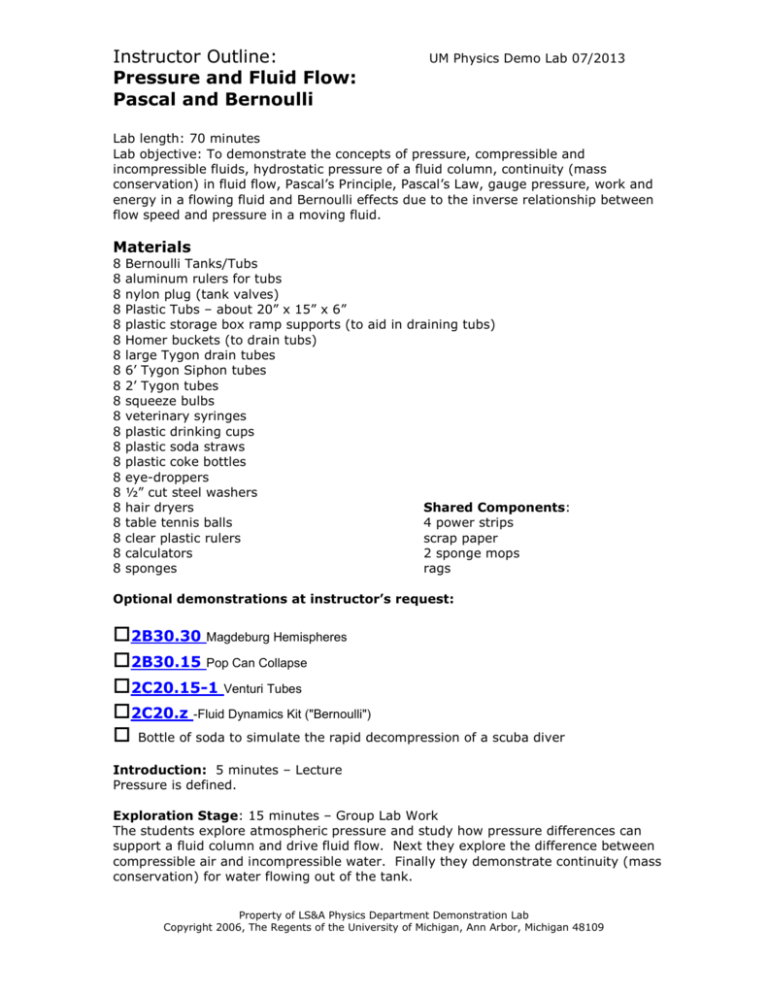
Instructor Outline: Pressure and Fluid Flow: Pascal and Bernoulli UM Physics Demo Lab 07/2013 Lab length: 70 minutes Lab objective: To demonstrate the concepts of pressure, compressible and incompressible fluids, hydrostatic pressure of a fluid column, continuity (mass conservation) in fluid flow, Pascal’s Principle, Pascal’s Law, gauge pressure, work and energy in a flowing fluid and Bernoulli effects due to the inverse relationship between flow speed and pressure in a moving fluid. Materials 8 8 8 8 8 8 8 8 8 8 8 8 8 8 8 8 8 8 8 8 8 Bernoulli Tanks/Tubs aluminum rulers for tubs nylon plug (tank valves) Plastic Tubs – about 20” x 15” x 6” plastic storage box ramp supports (to aid in draining tubs) Homer buckets (to drain tubs) large Tygon drain tubes 6’ Tygon Siphon tubes 2’ Tygon tubes squeeze bulbs veterinary syringes plastic drinking cups plastic soda straws plastic coke bottles eye-droppers ½” cut steel washers hair dryers Shared Components: table tennis balls 4 power strips clear plastic rulers scrap paper calculators 2 sponge mops sponges rags Optional demonstrations at instructor’s request: 2B30.30 Magdeburg Hemispheres 2B30.15 Pop Can Collapse 2C20.15-1 Venturi Tubes 2C20.z -Fluid Dynamics Kit ("Bernoulli") Bottle of soda to simulate the rapid decompression of a scuba diver Introduction: 5 minutes – Lecture Pressure is defined. Exploration Stage: 15 minutes – Group Lab Work The students explore atmospheric pressure and study how pressure differences can support a fluid column and drive fluid flow. Next they explore the difference between compressible air and incompressible water. Finally they demonstrate continuity (mass conservation) for water flowing out of the tank. Property of LS&A Physics Department Demonstration Lab Copyright 2006, The Regents of the University of Michigan, Ann Arbor, Michigan 48109 Analysis Stage: 5 minutes – lecture Atmospheric pressure is defined and quantified. Large forces due to atmospheric pressure are demonstrated by passing around the evacuated Magdeburg spheres. Pascal’s Principle and Pascal’s Law are introduced. Continuity is formally defined. Application Stage: 10 minutes – group lab-work The students construct a Cartesian diver and explain its operation using the concepts of pressure, density, compressibility and Pascal’s Principle. Analysis Stage: 5 minutes – Lecture The concepts of work and energy introduced in the context of a flowing fluid, stressing that the application of the Work-Energy Theorem to a drop of flowing fluid results in Bernoulli’s equation. The inverse relationship between fluid speed and pressure dictated by Bernoulli’s equation is introduced and demonstrated. Exploration Stage: 20 minutes – Group Lab Work The students next explore the consequences of energy conservation in a flowing fluid, first by comparing the motion of a horizontal stream of fluid to the motion of a horizontally launched projectile and then by considering energy conservation to relate the exit speed of the stream to the column height in the tank. The exit speed for fluid in a siphon is correlated with the column height driving the siphon flow. They discover that the depth the siphon inlet is submerged below the water surface does not affect the exit speed for the siphon. Application Stage: 5 minutes – Group Lab-Work The students trap a table tennis ball in the flow column from a hair drier and explain the effect using the inverse pressure-speed result from Bernoulli’s equation and the concept of force as the product of a pressure difference and the cross-sectional area of an object. Analysis and Summary Stage: 5 minutes – Lecture The results from the siphon experiment are reviewed and the work-energy relationships determining the observed flow behavior are discussed. Concepts developed: 1. Definition of Pressure 2. Compressible and incompressible fluids 3. Mass conservation (continuity) during incompressible fluid flow. 4. Pascal’s Principle: Pressure is transmitted uniformly throughout a fluid and to the vessel walls. 5. Pascal’s Law: The additional pressure due to a fluid column of height h is given by P gh . 6. Gauge pressure is the excess pressure relative to atmospheric pressure. The gauge pressure at a depth h in a fluid is therefore Pgauge gh 7. Application of the Work-Energy Theorem to a moving fluid yields Bernoulli’s equation. 8. The exit speed for fluid from a hole or siphon is dictated by energy conservation and depends on the height of the fluid level above the exit hole. 9. For a fluid flowing in a level pipe, Bernoulli’s equation, and hence energy conservation, dictates that pressure decreases as speed increases. Property of LS&A Physics Department Demonstration Lab Copyright 2006, The Regents of the University of Michigan, Ann Arbor, Michigan 48109
